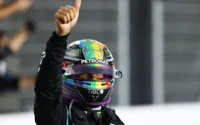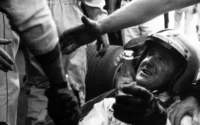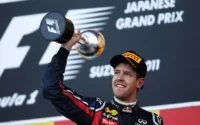Quiet, reserved, private, well-liked, and undoubtedly fast, Giancarlo Fisichella was tipped to be a successor to greats like Prost, Senna, and Stewart. Though he consistently outpaced some teammates, except for the likes of world champion Fernando Alonso, luck often seemed to abandon him. Despite his undeniable speed, it wasn’t until 2005 that he had genuinely competitive equipment.
| Nationality | Italian |
|---|---|
| Born | Giancarlo Fisichella 14 January 1973 Rome, Italy |
Like many Formula One drivers, Fisichella began kart racing as a youngster. In 1992, he competed in the Italian Formula Three series with RC Motorsport, finishing runner-up in 1993 and winning the championship in 1994, with victories in Monaco and Macau. He briefly left open-wheel racing to drive for Alfa Romeo in the international touring car series before moving to Formula One in 1996 with Minardi. Mid-season, he was replaced by Giovanni Lavaggi due to funding issues.
Fisichella made his full F1 debut in 1997 with Jordan, scoring his first podium in Canada and outperforming reigning Formula Nippon champion Ralf Schumacher. At Hockenheim, he led much of the race before a puncture, and Gerhard Berger‘s inspired drive denying him a win. A superb second-place finish behind Schumacher at Spa in wet conditions labelled him as a real talent, leading to his move to Benetton in 1998.
Unfortunately, the Benetton move was poor, as they no longer had works Renault engines and wouldn’t win another race. Early in 1998, promising performances included second places at Montreal and Monaco, but gearbox issues and a clash with Jean Alesi tainted his season. The team’s performance dropped in the second half of the year, limiting his points.
The 1999 season was similarly inconsistent, with a few podiums and heartbreak at the Nürburgring when a crash cost him a potential win. In 2000, early podiums were followed by a poor second half, and despite outclassing teammate Alex Wurz, he saw limited success. In 2001, with Renault owning the team, experiments with wide-angle engines hampered performance, but Fisichella still managed a strong drive at Spa to secure a podium. However, he was forced to leave for Jordan in 2002, where he struggled with an uncompetitive car.
In 2003, despite Jordan using Ford engines, a freak win in Brazil gave Fisichella his first victory. He moved to Sauber in 2004, hoping to use it as a springboard to Ferrari, and drove well, out-driving teammate Felipe Massa. A rekindled interest from old team boss Flavio Briatore led to his return to Benetton (now Renault) in 2005. A win at Melbourne seemed like a breakthrough, but poor luck and Fernando Alonso‘s dominance overshadowed him. Technical problems and missed opportunities, like a last-lap loss to Kimi Raikkonen at Suzuka, raised questions about his mindset.
In 2006, he remained overshadowed by Alonso but was retained for 2007 when Alonso left for McLaren. In 2007, Fisichella became Renault’s team leader, with young Finn Heikki Kovalainen as his teammate and Nelson Piquet Jr. as the team’s test driver.
In 2008, with Renault re-signing Fernando Alonso and Nelson Piquet Jr. promoted to a full-time race seat, Giancarlo Fisichella joined the Force India team as the number-one driver alongside Adrian Sutil. This was his third stint with the former Jordan team. During the 2008 Monaco Grand Prix, he became the ninth driver to compete in 200 Grands Prix. Despite a few promising moments, such as briefly running fifth in Brazil, Fisichella and the Force India team finished the season without any points.
In 2009, Fisichella had a remarkable season driving the new Force India VJM02 powered by a Mercedes-Benz engine. He started the 2009 Australian Grand Prix from 15th and finished 11th, but faced challenging conditions in Malaysia, where he finished 18th after a spin. The season’s highlight came at the 2009 Belgian Grand Prix, where he secured Force India’s first pole position and finished second, earning the team’s first points and podium.
Amidst rumours, Fisichella replaced Luca Badoer at Ferrari, starting from the 2009 Italian Grand Prix following Felipe Massa’s injury. He signed a contract as Ferrari’s driver for the rest of the 2009 season and as a reserve driver for 2010, though he remained open to racing for another team in 2010. Despite being linked to Sauber and Force India, he stayed with Ferrari as a test driver in 2010.
At the end of 2010, Fisichella was replaced by Jules Bianchi as Ferrari’s test driver but remained part of the team but would never drive again in Formula 1. Outside of Formula One, Fisichella has driven for AF Corse at various sportscar racing events, becoming a two-time class winner at the 24 Hours of Le Mans and a class winner at Petit Le Mans.
Giancarlo Fisichella Formula One World Championship career
| Active years | 1996–2009 |
|---|---|
| Teams | Minardi, Jordan, Benetton, Sauber, Renault, Force India, Ferrari |
| Entries | 231 (229 starts) |
| Championships | 0 |
| Wins | 3 |
| Podiums | 19 |
| Career points | 275 |
| Pole positions | 4 |
| Fastest laps | 2 |
| First entry | 1996 Australian Grand Prix |
| First win | 2003 Brazilian Grand Prix |
| Last win | 2006 Malaysian Grand Prix |
| Last entry | 2009 Abu Dhabi Grand Prix |
Giancarlo Fisichella Teammates
| 14 drivers | Involvement | First Year | Last Year |
|---|---|---|---|
| Pedro Lamy | 8 | 1996 | |
| Ralf Schumacher | 17 | 1997 | |
| Alexander Wurz | 49 | 1998 | 2000 |
| Jenson Button | 17 | 2001 | |
| Takuma Sato | 17 | 2002 | |
| Ralph Firman | 15 | 2003 | |
| Zsolt Baumgartner | 3 | 2003 | |
| Björn Wirdheim | 1 | 2003 | |
| Satoshi Motoyama | 1 | 2003 | |
| Felipe Massa | 18 | 2004 | |
| Fernando Alonso | 37 | 2005 | 2006 |
| Heikki Kovalainen | 17 | 2007 | |
| Adrian Sutil | 30 | 2008 | 2009 |
| Kimi Raikkonen | 5 | 2009 |
Race Wins
| Win Number | Grand Prix |
|---|---|
| 1 | 2003 Brazilian Grand Prix |
| 2 | 2005 Australian Grand Prix |
| 3 | 2006 Malaysian Grand Prix |
Complete Formula One Results
| Year | Entrant | Chassis | Engine | 1 | 2 | 3 | 4 | 5 | 6 | 7 | 8 | 9 | 10 | 11 | 12 | 13 | 14 | 15 | 16 | 17 | 18 | 19 | WDC | Points |
|---|---|---|---|---|---|---|---|---|---|---|---|---|---|---|---|---|---|---|---|---|---|---|---|---|
| 1996 | Team Minardi | Minardi M195B | Ford EDM2 3.0 V8 Ford EDM3 3.0 V8 | AUS Ret | BRA | ARG | EUR 13 | SMR Ret | MON Ret | ESP Ret | CAN 8 | FRA Ret | GBR 11 | GER | HUN | BEL | ITA | POR | JPN | NC | 0 | |||
| 1997 | Benson & Hedges Total Jordan Peugeot | Jordan 197 | Peugeot A14 3.0 V10 | AUS Ret | BRA 8 | ARG Ret | SMR 4 | MON 6 | ESP 9 | CAN 3 | FRA 9 | GBR 7 | GER 11 † | HUN Ret | BEL 2 | ITA 4 | AUT 4 | LUX Ret | JPN 7 | EUR 11 | 8th | 20 | ||
| 1998 | Mild Seven Benetton Playlife | Benetton B198 | Playlife GC37-01 3.0 V10 | AUS Ret | BRA 6 | ARG 7 | SMR Ret | ESP Ret | MON 2 | CAN 2 | FRA 9 | GBR 5 | AUT Ret | GER 7 | HUN 8 | BEL Ret | ITA 8 | LUX 6 | JPN 8 | 9th | 16 | |||
| 1999 | Mild Seven Benetton Playlife | Benetton B199 | Playlife FB01 3.0 V10 | AUS 4 | BRA Ret | SMR 5 | MON 5 | ESP 9 | CAN 2 | FRA Ret | GBR 7 | AUT 12 † | GER Ret | HUN Ret | BEL 11 | ITA Ret | EUR Ret | MAL 11 | JPN 14 † | 9th | 13 | |||
| 2000 | Mild Seven Benetton Playlife | Benetton B200 | Playlife FB02 3.0 V10 | AUS 5 | BRA 2 | SMR 11 | GBR 7 | ESP 9 | EUR 5 | MON 3 | CAN 3 | FRA 9 | AUT Ret | GER Ret | HUN Ret | BEL Ret | ITA 11 | USA Ret | JPN 14 | MAL 9 | 6th | 18 | ||
| 2001 | Mild Seven Benetton Renault | Benetton B201 | Renault RS21 3.0 V10 | AUS 13 | MAL Ret | BRA 6 | SMR Ret | ESP 14 | AUT Ret | MON Ret | CAN Ret | EUR 11 | FRA 11 | GBR 13 | GER 4 | HUN Ret | BEL 3 | ITA 10 | USA 8 | JPN 17 † | 11th | 8 | ||
| 2002 | DHL Jordan Honda | Jordan EJ12 | Honda RA002E 3.0 V10 | AUS Ret | MAL 13 | BRA Ret | SMR Ret | ESP Ret | AUT 5 | MON 5 | CAN 5 | EUR Ret | GBR 7 | FRA DNQ | GER Ret | HUN 6 | BEL Ret | ITA 8 | USA 7 | JPN Ret | 11th | 7 | ||
| 2003 | B&H Jordan Ford | Jordan EJ13 | Ford RS1 3.0 V10 | AUS 12 † | MAL Ret | BRA 1 | SMR 15 † | ESP Ret | AUT Ret | MON 10 | CAN Ret | EUR 12 | FRA Ret | GBR Ret | GER 13 † | HUN Ret | ITA 10 | USA 7 | JPN Ret | 12th | 12 | |||
| 2004 | Sauber Petronas | Sauber C23 | Petronas 04A 3.0 V10 | AUS 10 | MAL 11 | BHR 11 | SMR 9 | ESP 7 | MON Ret | EUR 6 | CAN 4 | USA 9 † | FRA 12 | GBR 6 | GER 9 | HUN 8 | BEL 5 | ITA 8 | CHN 7 | JPN 8 | BRA 9 | 11th | 22 | |
| 2005 | Mild Seven Renault F1 Team | Renault R25 | Renault RS25 3.0 V10 | AUS 1 | MAL Ret | BHR Ret | SMR Ret | ESP 5 | MON 12 | EUR 6 | CAN Ret | USA DNS | FRA 6 | GBR 4 | GER 4 | HUN 9 | TUR 4 | ITA 3 | BEL Ret | BRA 5 | JPN 2 | CHN 4 | 5th | 58 |
| 2006 | Mild Seven Renault F1 Team | Renault R26 | Renault RS26 2.4 V8 | BHR Ret | MAL 1 | AUS 5 | SMR 8 | EUR 6 | ESP 3 | MON 6 | GBR 4 | CAN 4 | USA 3 | FRA 6 | GER 6 | HUN Ret | TUR 6 | ITA 4 | CHN 3 | JPN 3 | BRA 6 | 4th | 72 | |
| 2007 | ING Renault F1 Team | Renault R27 | Renault RS27 2.4 V8 | AUS 5 | MAL 6 | BHR 8 | ESP 9 | MON 4 | CAN DSQ | USA 9 | FRA 6 | GBR 8 | EUR 10 | HUN 12 | TUR 9 | ITA 12 | BEL Ret | JPN 5 | CHN 11 | BRA Ret | 8th | 21 | ||
| 2008 | Force India F1 Team | Force India VJM01 | Ferrari 056 2.4 V8 | AUS Ret | MAL 12 | BHR 12 | ESP 10 | TUR Ret | MON Ret | CAN Ret | FRA 18 | GBR Ret | GER 16 | HUN 15 | EUR 14 | BEL 17 | ITA Ret | SIN 14 | JPN Ret | CHN 17 | BRA 18 | 19th | 0 | |
| 2009 | Force India F1 Team | Force India VJM02 | Mercedes FO108W 2.4 V8 | AUS 11 | MAL 18 † | CHN 14 | BHR 15 | ESP 14 | MON 9 | TUR Ret | GBR 10 | GER 11 | HUN 14 | EUR 12 | BEL 2 | 15th | 8 | |||||||
| Scuderia Ferrari Marlboro | Ferrari F60 | Ferrari 056 2.4 V8 | ITA 9 | SIN 13 | JPN 12 | BRA 10 | ABU 16 |
Sources: Historicracing.com and Wikipedia.com






